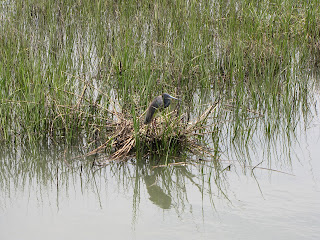In the words of a former student in another situation... “Miss! There’s a lot of white people here.” And black ones. But it took nearly an entire week to find the Latin brown so familiar to me.
One black man on the bus told us that Charleston didn’t have as many racial tensions as other Southern cities, that they all got along here. It did seem so to us. Our bus drivers advised us (we even ran into one mowing weeds the following day and he spoke, while another told us she’d seen us earlier riding bikes), our fellow passengers visited with us (what DO you tell the lady asking for advice on how to collect unemployment after getting a job?), and every shop keeper and candy seller wanted to know where we were from. One even knew that New Mexico was next to Colorado!
When traveling with a group of 30 southern schoolteachers, one may sit back enjoy the chivalry, extended not only to their own, but to every lady on the plane. One book said a Southern gentleman would rather get off the bus than see a lady stand while he was sitting, and I do believe it might be true. One evening we were caught with a large group of others waiting in the rain for the free trolleys. Two elderly gentlemen stayed in the rain until every lady was on board.
I believe I may say that I felt hostility from only one person in the entire city of Charleston. One night in the rain, a lady dressed in a business suit entered the trolley. The moment she climbed on, I wondered about her eyes. She looked upward and around, refusing to look at anyone, and it was clear she was angry. When she spoke, I understood. She said only, “D-- this rain *&%...” but it was not the voice of a woman, rather the voice of a young man. Both the conversation and the roaming eyes continued throughout the ride; the sorrow in my heart reminded me of the days in Bogota, where this was a common phenomena, and just as sad.
----
We took two tours of the area, one by carriage, the other by boat. The boat took us out into Charleston Harbor visit Ft. Sumter. Who in the world sees a tiny island and decides to haul in stones to build a fort? I was impressed, although I might have been more impressed by the cargo ship full of railroad cars. My brain can hardly handle the idea that a huge railroad car was only a tiny square on a tiny boat floating in the middle of a tremendous ocean.

The carriage ride took us through the historical residential area of Charleston; we were pulled by two mules known as Otis and Battery (as in weaponry). We later walked into a couple of sights for additional tours. The Powder Magazine was built long before the Revolutionary War, but the thick walls and arched ceiling (formerly covered in sand) were meant to contain the explosion should an accident occur. The Nathaniel Rutledge House was built by a man and his wife determined to attract appropriate suitors for their teenage daughters. It has a freestanding staircase built with no nails. Unfortunately, I was highly distracted during this tour by the injured carriage horse in the street. The street was blocked off and eight policemen were investigating the scene.
----
Food was obviously my favorite thing in Charleston, but I might also mention the clean, spacious city buses that we rode for $1.75 each and the free trolleys that went downtown. Also worth noting is the “Notso Hostel.” I thought it was great; we visited with a guy from Liverpool, England, a lady from Germany, and we ate free bagels with Nutella on them. Jessica was unimpressed by the neighborhood and the plastic covers on the mattresses (She hadn't really planned for a safari), so it was only a one night experience.
Anyway, I also find some other interesting "things," like the bridge across the harbor. To imagine the engineering and ingeniousness that went into its construction is impossible. Or the South Carolina flag. Contrary to popular opinion, there is no moon. Rather the crescent is from the armor worn by the early defenders of the walled city. South Carolinians won my heart right away; most of us know they were the first state to secede from the Union, but how many realize they were the first colony to declare independence from England?
 |
| South Carolina rally for less government |


































